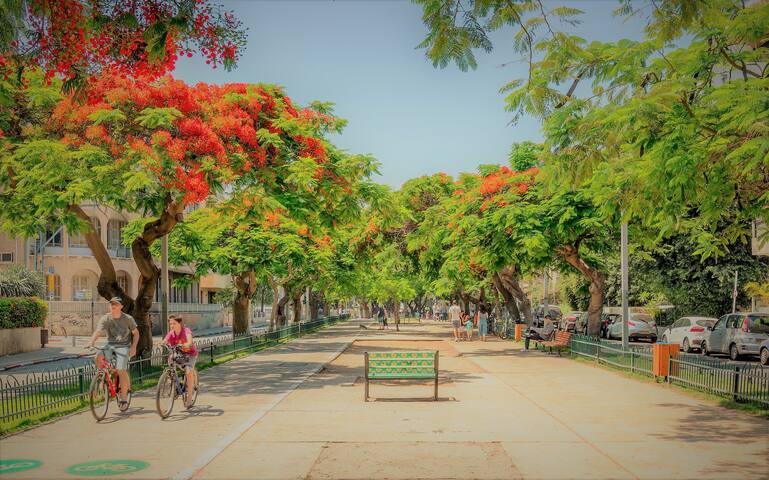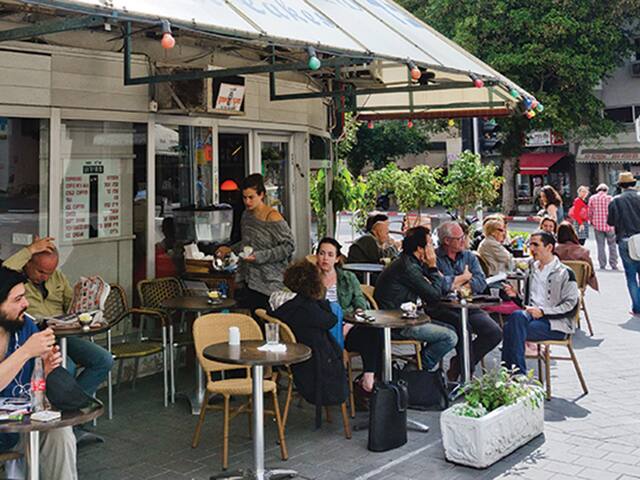אתרי תיירות
Sderot Ben Gurion
Sderot Ben GurionSderot Ben Gurion
Sderot Ben Gurionשכונות
Rabin Square
From Wikipedia, the free encyclopedia
Jump to navigationJump to search
Rabin Square
Rabin Squre eco pool.jpg
Rabin Square and Tel Aviv City Hall from the southeastern corner
Wikimedia | © OpenStreetMap
TypeMunicipal (public space)
Coordinates32°4′51.18″N 34°46′50.06″E
Created1964
Operated byTel Aviv Municipality
StatusOpen
Rabin Square (Hebrew: כיכר רבין, Kikar Rabin), formerly Kings of Israel Square (Hebrew: כיכר מלכי ישראל, Kikar Malkhey Yisrael), is a large public city square in the center of Tel Aviv, Israel. Over the years it has been the site of numerous political rallies, parades, and other public events. In 1995 the square was renamed 'Rabin Square' following the assassination of Yitzhak Rabin which occurred there on November 4 of that year.[1]
The square is surrounded by the city hall building to the north (designed by the architect Menachem Cohen), Ibn Gabirol Street to the east, Malkhey Yisrael (Kings of Israel) Street to the south and Hen Boulevard to the west. It was designed alongside the city hall in 1964 by architects Yaski and Alexandroni.
History
Until the early 1990s, the square was used on Israel's Independence Day, as a public exhibition ground for IDF field units (mostly armor and heavy artillery). The square has also been the site of many political rallies and demonstrations.
Prime Minister of Israel, Yitzhak Rabin, was assassinated at the conclusion of a peace rally at the site on November 4, 1995. In the days following the event, thousands of Israelis gathered at the square to commemorate Rabin. The young people who came to mourn Rabin were dubbed the "Candles Youth" (Hebrew: נוער הנרות, Noar HaNerot) after the many yahrzeit candles they lit.[2] A segment of the graffiti they drew upon the nearby walls has been preserved.
A memorial stands on the spot where Rabin was assassinated (at the northeast corner of the square, below City Hall). Part of the memorial is a small, open legacy wall for Rabin. Near the south end of the square is a memorial sculpture designed by Israeli artist Yigal Tumarkin commemorating the Holocaust.
Renovation plans
In the late 1990s and early 2000s a great deal of criticism had been voiced about the Square's appearance, most directed at the City Hall building. What in the 1960s was one of the city's biggest and most impressive architectural designs came to be considered by critics as one of the city's worst eyesores. Plans have been made (most of which have even been approved) to renovate the whole square and City Hall. These include giving City Hall a more modern look to fit in with the many new skyscrapers in Tel Aviv, and the construction of a large underground parking complex underneath the square to alleviate the lack of parking in the area. Opposition to the renovation plans mostly centers around arguments that the design of the square and City Hall are part of Tel Aviv's history and should be preserved. As a result of this opposition, major reconstruction has been delayed. However, in 2010 a minor renovation project was carried out, in which an ecological water pool was constructed near the Holocaust commemorative monument, and around it a deck with a recreational area.[3]
References
Place Rabin
Dizengoff Street in central Tel Aviv is one of the city’s most iconic streets. Originally described as the “Champs-Élysées of Tel Aviv”, Dizengoff Street declined after the 1970’s and the opening of Tel Aviv’s most significant shopping mall, the Dizengoff Center in the southern portion of the street. In recent years, however, Dizengoff Street has seen something of a revival, with cafes and restaurants, boutique clothes stores, and numerous design shops opening up.
About Dizengoff Street?
The fountain at Dizengoff Square, Dizengoff Street, Tel AvivThe fountain at Dizengoff Square, Dizengoff Street, Tel Aviv. Photo: Idan Matalon
Dizengoff Street runs from Tel Aviv Port in the north, about 3km southwards, to its end at Ibn Gbirol Street, near Chen Boulevard and the Habima Cultural Center. The streets runs through the ‘Old North’ of the city, right into the ‘Lev Hair’ – the center of town. The street is named after Meir Dizengoff, the first mayor of Tel Aviv and was built during the 1920’s as part of the original urban development plan of Tel Aviv.
Dizengoff Street and those surrounding it, particularly in the southern half of the street, feature some of Tel Aviv’s iconic Bauhaus Buildings which have given Tel Aviv the nickname, the White City.
Dizengoff Square
Dizengoff Square with its famous fountain, ‘Fire and Water’ is one of the most iconic sights of Tel Aviv. The square sits above Dizengoff Street which passes underneath in an underpass. The square was built in 1934 and named for Zina Dizengoff, Meir Dizengoff’s wife.
The fountain which sits in the center of Dizengoff Square was designed by Yaacov Agam, one of the pioneers of the ‘kinetic art’ movement and opened in 1986. The fountain was fully restored in recent years having previously fallen into disrepair and is once again an icon of Tel Aviv.
Dizengoff Center
The Dizengoff Center is Tel Aviv’s first major shopping mall which opened gradually in the late 1970’s and early 1980’s. Located at the junction of Dizengoff Street and King George Street, the Dizengoff Center features over 400 stores and is unique in design in that it is situated on both sides of Dizengoff Street, with bridges connecting the two malls. The Dizengoff Center houses many specialty stores as well as the regular stores found in every Israeli mall, a cinema, and a large parking lot.
271 recommandé par les habitants
Dizengoff Street
Dizengoff Street
Dizengoff Street in central Tel Aviv is one of the city’s most iconic streets. Originally described as the “Champs-Élysées of Tel Aviv”, Dizengoff Street declined after the 1970’s and the opening of Tel Aviv’s most significant shopping mall, the Dizengoff Center in the southern portion of the street. In recent years, however, Dizengoff Street has seen something of a revival, with cafes and restaurants, boutique clothes stores, and numerous design shops opening up.
About Dizengoff Street?
The fountain at Dizengoff Square, Dizengoff Street, Tel AvivThe fountain at Dizengoff Square, Dizengoff Street, Tel Aviv. Photo: Idan Matalon
Dizengoff Street runs from Tel Aviv Port in the north, about 3km southwards, to its end at Ibn Gbirol Street, near Chen Boulevard and the Habima Cultural Center. The streets runs through the ‘Old North’ of the city, right into the ‘Lev Hair’ – the center of town. The street is named after Meir Dizengoff, the first mayor of Tel Aviv and was built during the 1920’s as part of the original urban development plan of Tel Aviv.
Dizengoff Street and those surrounding it, particularly in the southern half of the street, feature some of Tel Aviv’s iconic Bauhaus Buildings which have given Tel Aviv the nickname, the White City.
Dizengoff Square
Dizengoff Square with its famous fountain, ‘Fire and Water’ is one of the most iconic sights of Tel Aviv. The square sits above Dizengoff Street which passes underneath in an underpass. The square was built in 1934 and named for Zina Dizengoff, Meir Dizengoff’s wife.
The fountain which sits in the center of Dizengoff Square was designed by Yaacov Agam, one of the pioneers of the ‘kinetic art’ movement and opened in 1986. The fountain was fully restored in recent years having previously fallen into disrepair and is once again an icon of Tel Aviv.
Dizengoff Center
The Dizengoff Center is Tel Aviv’s first major shopping mall which opened gradually in the late 1970’s and early 1980’s. Located at the junction of Dizengoff Street and King George Street, the Dizengoff Center features over 400 stores and is unique in design in that it is situated on both sides of Dizengoff Street, with bridges connecting the two malls. The Dizengoff Center houses many specialty stores as well as the regular stores found in every Israeli mall, a cinema, and a large parking lot.


